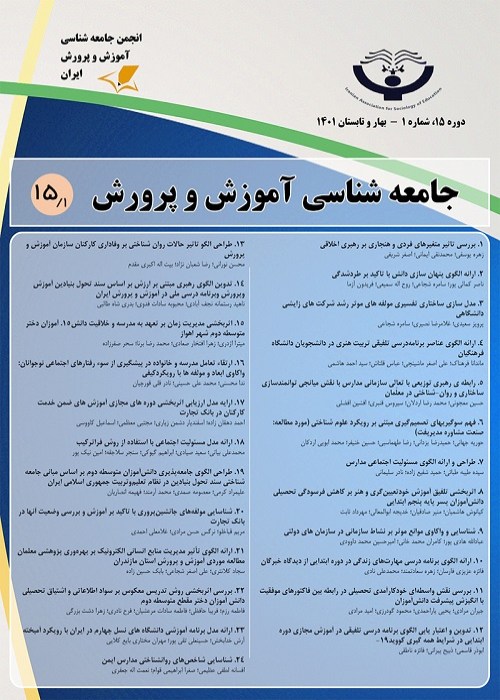Identifying and determining the dimensions of the constituent components and factors affecting the discovery and support of the talents of junior high school students in deprived areas(Case study: Education of cities in Tehran province)
The aim of this study was to identify and determine the dimensions of the constituent components and factors affecting the discovery and support of the talents of junior high school students in deprived areas of education in the cities of Tehran province.
The present study was applied in terms of purpose and in terms of data collection was a mixed research (qualitative-quantitative). The statistical population in the qualitative section included academic experts and knowledgeable individuals in the field of talent identification in Tehran and in the quantitative section included all high school teachers in the first year of the cities of Tehran province to 1522 people. The sample size was estimated in the qualitative part with theoretical saturation (20 people) and in the quantitative part based on Cochran's formula 307 people. Purposeful sampling was used to select the sample in the qualitative part and stratified random sampling was used in the quantitative part. Data collection tools were qualitative, interview and quantitative, researcher-made questionnaire based on a 5-item scale. The validity of the questionnaire was confirmed in terms of form and content by several experts, the validity was confirmed by calculating the slope and the validity was confirmed by calculating the square root of the AVE. The reliability of the questionnaire was 0.86 through Cronbach's alpha for the whole questionnaire. Cronbach's alpha, tangent (AVE) tests, AVE root matrix, Kolmogorov-Smirnov, confirmatory factor analysis and t-test were used to analyze the data.
The results led to the identification of 20 components and 96 indicators, of which 6 dimensions and 16 effective components including structural factors (culture, education, managerial support), family factors (family economic facilities, physical facilities, educational and occupational status of parents), factors Social (communication, social responsibility), individual factors (self-confidence, trustworthiness, risk-taking, self-motivation), environmental factors (school, teacher), and contextual factors (student age and gender) are influential.
Among these, path coefficients indicated that individual factors with path coefficient (0.26) were the most important factor and contextual factors with coefficient (0.24) were the second factor, environmental factors (0.19), third factor, family factors (0.12) and fourth factor. Structural factors (0.118) were the fifth factor and finally social factors (0.11) were the last effective factor.
- حق عضویت دریافتی صرف حمایت از نشریات عضو و نگهداری، تکمیل و توسعه مگیران میشود.
- پرداخت حق اشتراک و دانلود مقالات اجازه بازنشر آن در سایر رسانههای چاپی و دیجیتال را به کاربر نمیدهد.


